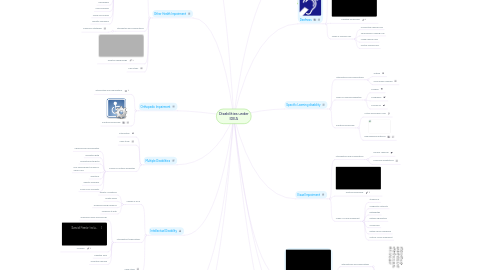
1. Developmental Delay
1.1. Intervention/Modifications
1.2. Assistive Technology
2. Emotional Disturbance
2.1. Intervention/Modifications
2.2. Assistive Technology
2.3. Categories of Emotional Disturbances
2.3.1. Anxiety Disorder
2.3.2. Eating Disorder
2.3.3. Bipolar Disorder
2.3.4. Conduct Disorder
2.3.5. OCD
2.3.6. Psychotic Disorder
3. Intellectual Disability
3.1. Causes of an ID
3.1.1. Genetic Conditions
3.1.2. Health Issues
3.1.3. Problems During Pregancy
3.1.4. Problems at birth
3.2. Intervention/Modifications
3.2.1. Individual Family Services Plan
3.2.2. Inclusion
3.2.3. Adaptive Skills
3.2.4. Transition Planning
3.3. Case Study
4. Multiple Disabilities
4.1. Intervention
4.2. Case Study
4.3. Causes of Multiple Disabilities
4.3.1. Chromosomal Abnormalities
4.3.2. Premature Birth
4.3.3. Difficulties After Birth
4.3.4. Poor Development of Brain or Spinal Cord
4.3.5. Infections
4.3.6. Genetic Disorders
4.3.7. Injury From Accidents
5. Orthopedic Impairment
5.1. Intervention and Modifications
5.2. Assistive Technology
6. Other Health Impairment
6.1. Types of Health Impairments
6.1.1. Rheumatic Fever
6.1.2. ADD/ADHD
6.1.3. Nephritis
6.1.4. Leukemia
6.1.5. Diabetes
6.1.6. Heart Conditions
6.1.7. Epilepsy
6.1.8. Hemophelia
6.1.9. Lead Poisoning
6.1.10. Sickle Cell Anemia
6.1.11. Tourette Syndrome
6.2. Intervention and Modifications
6.2.1. Classroom Strategies
6.3. Assistive Teachnology
6.4. Case Study
7. Speech or language impairment
7.1. Types of Speech and Language Disorders
7.1.1. Articulation
7.1.2. Voice
7.1.3. Language
7.1.4. Fluency
7.2. Intervention and Modifications
7.2.1. Hearing Impairments
7.2.2. Speech and Language Coaches
7.3. Assistive Technology
7.3.1. Electronic Communication Devices
8. Autism
8.1. Assistive Technologies
8.1.1. LAMP: Language Acquisition through Motor Planning
8.1.2. Picture Exchange Communication
8.2. Case Studies
8.3. Autism Spectrum Disorders
8.3.1. Pervasive Development Disorder
8.3.2. Rett Syndrome
8.3.3. Autism
8.3.4. Asperger Syndrome
8.3.5. Childhood Disintegrative Disorder
8.4. Intervention and Modifications
9. Deaf-Blindness
9.1. Interventions and Modifications
9.1.1. Deaf-Blind Manual Alphabet
9.1.2. Mutual Tactile Attention
10. Deafness
10.1. Intervention and Modifications
10.1.1. ASL
10.2. Assistive Technology
10.3. Types of Hearing Loss
10.3.1. Conductive Hearing Loss
10.3.2. Sensorineural Hearing Loss
10.3.3. Mixed Hearing Loss
10.3.4. Central Hearing Loss
11. Hearing Impairment
12. Specific Learning disability
12.1. Interventions and Modifications
12.1.1. Testing
12.1.2. Small Group Learning
12.2. Types of Learning Disabilities
12.2.1. Dyslexia
12.2.2. Dysgraphia
12.2.3. Dyscalcula
12.3. Assistive Technology
12.3.1. Virtual Worlds Real Lives
12.3.2. iPad Reading Assistance
13. Traumatic Brain Injury
13.1. Intervention/Modications
13.2. Signs of traumatic brain injury
13.2.1. Physical Disabilities
13.2.2. Difficulties with thinking
13.2.3. Social/Behavioral/Emotional Projlems
14. Visual Impairment
14.1. Interventions and Modifications
14.1.1. Sensory Learning
14.1.2. Classroom Adaptations
14.2. Assitive Technology
14.3. Types of Visual Impairment
14.3.1. Strabismus
14.3.2. Congenital Cataracts
14.3.3. Retinopathy
14.3.4. Retinus Pigmentosa
14.3.5. Colonboma
14.3.6. Retina Nerve Hypoplasia
14.3.7. Cortical Visual Impairment
